- | Corporate Welfare Corporate Welfare
- | Policy Briefs Policy Briefs
- |
The State of Occupational Licensure in Missouri
When a state imposes licensing rules on an occupation, workers cannot legally practice that trade without fulfilling a set of requirements. Missouri requires about a quarter of its workforce to have a license or certification. Occupational licensing is ostensibly intended to protect the public from unsafe and low-quality service, but there is little evidence this intention is realized. Rather, there is a growing consensus among economists that these rules serve to protect incumbent providers from competition by creating barriers for new entrants that lead to higher prices for consumers.
Occupational licensing across the US has expanded dramatically over the last 50 years. In 1950, 5 percent of the workforce was licensed through state laws, and in 2000 that number approached 20 percent. When federal licenses are also accounted for, one estimate for 2006 is that 29 percent of the workforce was licensed. This growth in licensure arises primarily from the growth in the number of occupations for which a license is required by the state, not from people switching from jobs that do not require occupational licenses to jobs that do. While there is a great deal of variation across states in the number of occupations for which a license is required as well as in the requirements to obtain a license, every state has seen an increase in both. Missouri is no exception.
A Snapshot of Missouri’s Occupational Licensure Regime
The government of Missouri has developed extensive licensing requirements. In 2015, the state licensed 21.3 percent of the workforce and certified another 5.4 percent. The Missouri Division of Professional Registration subjects 240 occupations to licensing.
A 2012 study by the Institute for Justice (IJ) examined occupational licensure laws for 102 low- to moderate-income occupations and found that Missouri requires a license for 31 of these occupations. Though this number is relatively low, obtaining any given license poses many substantial hurdles. In assessing the burdens the state imposes—including fees, exams, age requirements, grade requirements, and training and experience requirements—the report ranked Missouri’s licensing regime as more burdensome than that of 16 other states. On average, the Show-Me State requires 220 days of experience and training, $100 in fees, and one exam for each of those 31 occupations. Athletic trainers, barbers, gaming industry workers, animal breeders, manicurists, and many others face steep fines for operating in Missouri without a license.
Patterns in occupational licensing requirements contradict the idea that licensure is primarily used to protect public safety. Occupations that are less likely to involve risk to the public are often more highly controlled than riskier occupations. In Missouri, for example, emergency medical technicians (EMTs) must complete 23 days of training and pass
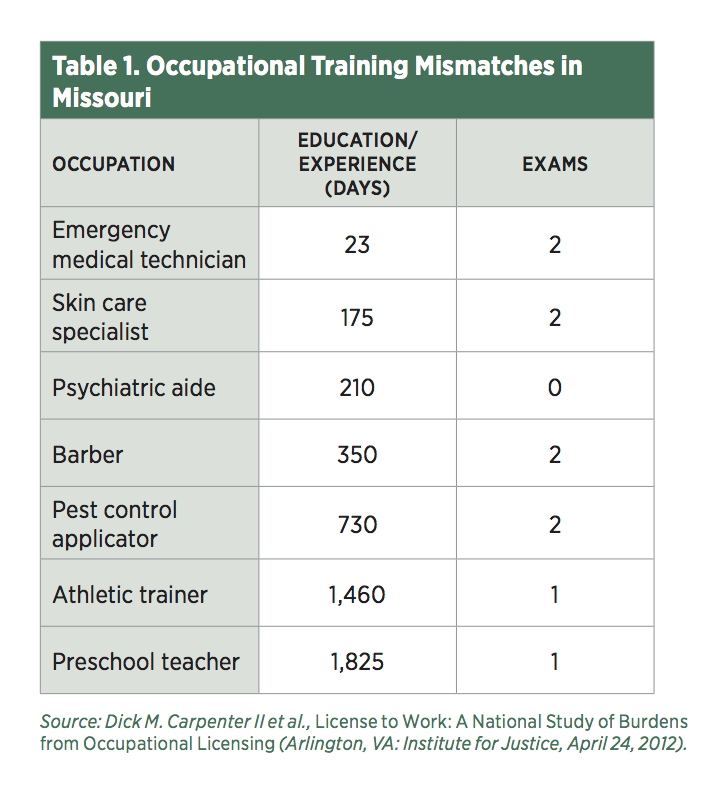
Missouri and California are the only two states to license psychiatric aides. In addition, Missouri licenses other rarely-licensed occupations like sign language interpreter, taxi driver, and pharmacy technician. The evidence suggests two things: First, licensing requirements do not improve the quality of the goods and services provided by licensed occupations (see the next section), and second, they exclude potential service providers who find the hurdles too costly to overcome. These hurdles limit competition for the incumbents in these protected trades, producing a doubly negative effect: First, occupational licensing requirements keep able people from entering trades they could otherwise learn quickly and perform sufficiently well, limiting employment opportunities for people without advanced skills or degrees. Second, protected industries can charge their customers higher prices than competitive industries, requiring low-income families to pay higher bills for basic services. Low-income consumers lose in particular. In the absence of licensure, a barber, for example, might offer discounted haircuts with fewer frills to those who would otherwise not be able to afford luxurious shops.
There is significant variation in licensing requirements for the same jobs across states. Boards can require a minimum level of education or experience, a steep processing fee, or a passing score on examinations. In Missouri, 14 of the 31 licenses identified by IJ require all three.
Figure 1 compares the state’s fee and experience requirements in these surveyed occupations to the national average. Missouri’s licensing requirements are considerably below the national average in three areas: number of occupations licensed, fees, and days lost to education and experience requirements.
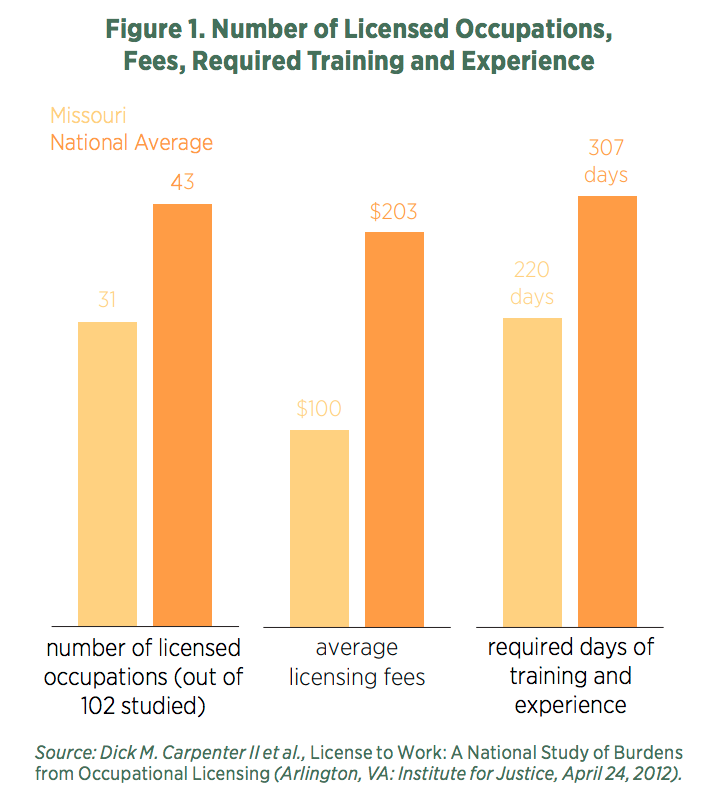
Though for many professions Missouri has less restrictive laws than its neighbors, there are some instances in which the reverse is true. For instance, Missouri’s requirements for pest control applicators are the fourth most restrictive in the country. To begin work, Missouri pest control applicators must accrue two years of experience, pay $50 in fees, and pass two exams. Meanwhile, their counterparts in nearby Kansas, Iowa, Arkansas, and Kentucky face no minimum level of education or experience, allowing them to get to work much sooner.
Similarly, massage therapists in Missouri also face steeper requirements than those in neighboring states. In both Oklahoma and Kansas, massage therapists do not need a license at all. Manicurists in Iowa face a much lighter regulatory burden than those in Missouri—a manicurist in Des Moines can begin work after completing one exam and nine days of training. The same job in St. Louis requires two exams and 85 days in training.
Industry domination of licensing boards is also problematic. Table 2 provides a snapshot of Missouri board composition. In Missouri, nearly 70 percent of licensing boards are required by statute to have a majority of members who are license holders.
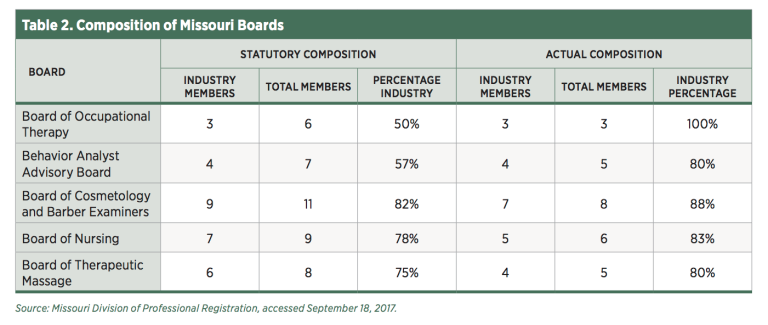
Fortunately, policy makers in Missouri are trying to lower barriers in a variety of occupations. An effort by Governor Greitens called “No MO Red Tape” aims to gather feedback on how regulations affect people. The initiative has collected thousands of public comments, many of which recount frustration with licensing requirements.
Governor Eric Greitens recently signed an executive order suspending all new rulemaking and requiring agencies to review existing regulations to ensure they are “essential to the health, safety, or welfare of Missouri residents.” Nearby states have also reformed their licensing practices. The Kentucky legislature passed a bill in 2016 eliminating the licensing requirement for hair braiders. In Nebraska, pending legislation could reform licensing requirements for estheticians, potato shippers, car salespeople, barbers, and many other workers.
Though Missouri should be proud of its comparatively low licensing requirements, there is more to be done to make low-income occupations accessible to people who are most likely to be stymied by barriers to entry.
The Economics of Occupational Licensure
Licensure and Quality
Licensure is justified by legislators and advocates as necessary to protect the public from low-quality services or potential health risks. It is theoretically possible that a well-designed quality screening system will ensure that only high-quality professionals join an occupation. However, limiting the supply of professionals undermines competition. Less competition means lower quality and higher prices. As Morris M. Kleiner put it, licensure ensures that “prices and wages will rise as a result of restricting the number of practitioners, which should tend to reduce quality received by consumers.” High prices may even push consumers out of the market entirely, inducing them to resort to far more risky do-it-yourself behavior. For example, one study found that more restrictive electrician licensing regimes are associated with fewer electricians per capita and that this, in turn, is associated with more accidental electrocutions.
The true effect of licensure on quality is an empirical question, since economic theory suggests that licensure can have opposing effects on quality. Licensing requirements can increase quality by restricting entry only to highly qualified professionals, or it can decrease quality by causing less competition, higher prices, and more do-it-yourself activities. A number of studies have assessed the effect of licensure on quality and the weight of evidence suggests that the two effects roughly cancel each other out. As Kleiner summarized in his review of the literature,
There is little to show that occupational licensure has a major effect on the quality of services received by consumers or on the demand for the services other than through potential price effects.
During the Obama Administration, the Department of the Treasury, together with the Council of Economic Advisors and the Department of Labor, issued a report (henceforth referred to as the Treasury Department Report) including a review of the literature that concluded,
With the caveats that the literature focuses on specific examples and that quality is difficult to measure, most research does not find that licensing improves quality or public health and safety.
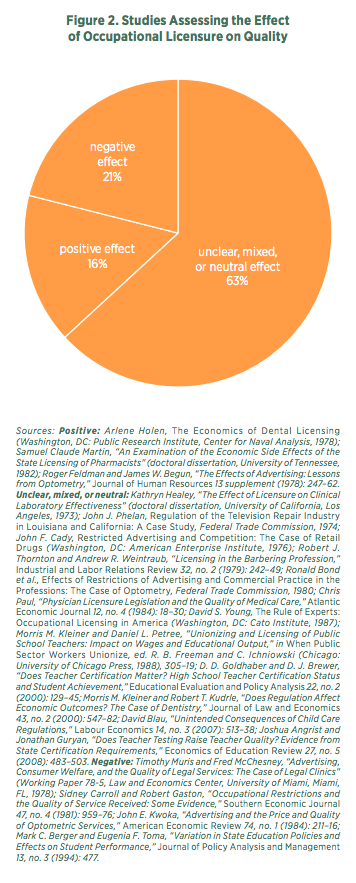
If occupational licensing were governed solely by the logic of promoting public safety, the same types of activities would be regulated in similar ways across states. In reality, there is wide variation across states in terms of occupations regulated and the stringency of those regulations. For example, four states heavily regulate interior designers, requiring them to have on average nearly 2,200 days of education and experience to practice their trade. Interior designers are able to offer their services in other states free from regulation with no apparent risk to the public.
Licensure is not the only or the most effective way to ensure quality. Tort law and civil and criminal laws against deceptive trade practices protect consumers from fraud and negligence. Firms already scrupulously guard their reputations and brands and seek the approval of third-party evaluators such as the Better Business Bureau and Angie’s List. The internet and smartphone applications have made shopping comparisons easy for consumers and have balanced, to some extent, information asymmetries typical of specialized services. If policymakers think private measures are insufficient to protect consumers, there are a number of public regulatory options that are more effective and less likely to be counterproductive than licensing. For example, the government can require that firms post bonds or simply register their businesses with the state so that consumers can be assured service providers are not fly-by-night operations.
Licensure and Prices
Economic theory predicts that a restriction in supply will result in higher prices. And, indeed, the empirical research consistently finds this to be the case. According to the Treasury Department Report,
The evidence on licensing’s effects on prices is unequivocal: many studies find that more restrictive licensing laws lead to higher prices for consumers. In 9 of the 11 studies we reviewed . . . significantly higher prices accompanied stricter licensing.
Similarly, McLaughlin, Ellig, and Shamoun found that licensure increased prices in all 19 of the studies they surveyed, ranging from optometry and law to dentistry and cosmetology.
The effects of these increased prices are not trivial. For example, state nurse practitioner licensing is estimated to increase the price of a well-child checkup by 3 to 16 percent, dental hygienist and dental assistant licensing is estimated to increase the price of a dental visit by 7 to 11 percent, and optometry licensing is estimated to increase the price of eye care by 5 to 13 percent. What’s more, none of these studies found that licensing increased quality.
Licensure and Regulatory Privilege
Writing in the Harvard Journal of Law and Public Policy, Paul Larkin Jr. notes a “curious and stubborn fact: Private individuals rarely urge governments to adopt licensing regimes, but private firms often do.” This fact conforms with the economic theory of regulation, which suggests that incumbent providers may use licensure to limit competition. By limiting supply and raising prices, these rules allow incumbent providers to earn artificially high profits. Indeed, the latest research suggests that licensure raises the wages of licensees by about 14 percent. Occupational licensing is a privilege granted by a regulatory agency to incumbent providers.
The social costs of this privilege are shouldered, in part, by consumers who have to pay higher prices than they would pay in more competitive markets. But the social costs also include the wages not earned by potential providers who are effectively excluded from the market by these regulations. With both the high prices for consumers and the forgone wages of would-be competitors, society is likely to experience a net loss from occupational licensing—what economists call deadweight loss. What’s more, incumbent professionals are willing to expend scarce resources convincing policymakers to contrive and maintain these privileges, a socially wasteful endeavor known as rent-seeking. Being few in number and established in their fields, these license holders generally find it easier to get politically organized than the large number of consumers and would-be competitors who are harmed by licensure.
The Disparate Impact of Licensure
Those who fail to obtain licenses pay a price in the form of lost income. Research suggests that these burdens often fall on particular communities. For example, military spouses are more likely to be in licensed professions and more likely to relocate from one licensing regime to another.
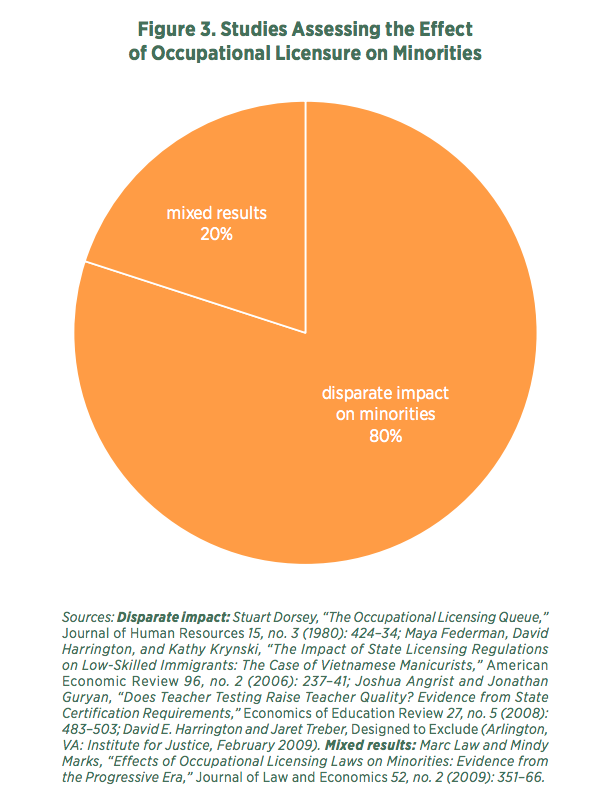
As shown in figure 3, McLaughlin, Ellig, and Shamoun’s survey of the literature shows that licensing was found to disparately affect ethnic minorities in four of five studies.
Reform
While occupational licensure is intended to protect consumers from harm, there are many other less-burdensome mechanisms to promote public safety. For instance, liability law and civil and criminal laws against fraud protect consumers. In addition, a host of private mechanisms ensure that market providers are accountable. These include private certifications, insurance, bond-posting, brand reputation, customer review platforms like Yelp and Google reviews, and the third-party validation of organizations like Angie’s List, Consumer Reports, and Underwriters Laboratories. Competition itself may be the best alternative to licensure. As the economist Alfred Kahn put it after decades of extensive work as a regulator and researcher, “Whenever competition is feasible, it is, for all its imperfections, superior to regulation as a means of serving the public interest.”
Policymakers wishing to reduce the social costs of their state’s occupational licensing could take the following steps:
- Pass legislation that sets an ambitious goal for the elimination of licenses and the reduction in licensing burdens.
- Establish an independent commission charged with examining the state’s licensing laws. Its first task should be to identify each license the state requires as well as the burdens associated with each license (fees, exams, required training, education, experience, and other limitations). The commission should be charged with evaluating all licenses, should not be dominated by members of the licensed professions, should include consumer representatives and representatives from organizations devoted to assist job-seekers, and should include third-party experts such as academics who have no financial stake in licensure. Furthermore, the commission should be guided by a set of criteria for evaluating regulations, as listed in table 3:
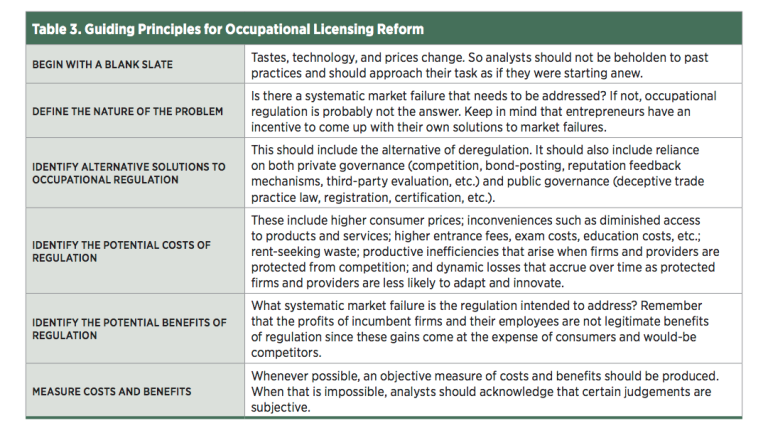
- The commission should be charged with performing a comprehensive review of all occupations, with the goal of identifying licensure requirements that can be eliminated or reformed. The authorizing legislation should commit elected officials to accepting the commission’s recommendations in their entirety or not at all.
The last provision is designed to overcome the public choice problems that plague licensure reform. In particular, whenever any individual license is evaluated, concentrated members of the industry are typically able to organize in defense of the license, while diffuse consumers and would-be competitors are unable to organize in opposition. The institutional structure that we recommend borrows elements from other reforms that have succeeded in eliminating favoritism. In particular, it allows elected officials to cast conspicuous votes in the public interest while giving them some degree of “cover” from the special interests that will inevitably be harmed by the elimination of their regulatory privilege.
